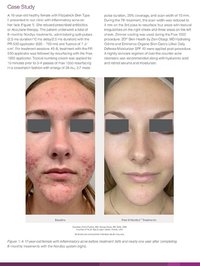Acne treatment with the Nordlys® system using Selective Waveband Technology (SWT®)
 Acne vulgaris is a common dermatologic disorder of the pilosebaceous unit that affects individuals of all skin types and ages.1 Prevention and early treatment of acne are a primary strategy against the formation of scars commonly associated with acne.2 Treatment with conventional topical and systemic therapy is based on severity of the acne.3 However, the onset of effect, antibiotic resistance, and significant side effects associated with oral and topical therapies affect patient compliance and success of treatment.1-4 Intense pulsed light (IPL) and nonablative fractional lasers that heat the sebaceous glands and their blood vessels, thereby decreasing sebum production, offer alternative treatments for acne, particularly for recalcitrant cases that fail conventional treatment.2•5
Acne vulgaris is a common dermatologic disorder of the pilosebaceous unit that affects individuals of all skin types and ages.1 Prevention and early treatment of acne are a primary strategy against the formation of scars commonly associated with acne.2 Treatment with conventional topical and systemic therapy is based on severity of the acne.3 However, the onset of effect, antibiotic resistance, and significant side effects associated with oral and topical therapies affect patient compliance and success of treatment.1-4 Intense pulsed light (IPL) and nonablative fractional lasers that heat the sebaceous glands and their blood vessels, thereby decreasing sebum production, offer alternative treatments for acne, particularly for recalcitrant cases that fail conventional treatment.2•5
1. Bhardwaj SS, Rohrer TE, Arndt K. Lasers and light therapy for acne vulgaris. Semin Cutan Med Surg. 2005 Jun;24(2):107-12.
2. Tan J, Kang S, Leyden J. Prevalence and risk factors of acne scarring among patients consulting dermatologists in the USA. J Drugs Dermatol. 2017:16:97-102.
3. Wanitphakdeedecha R, Tavechodperathum N, Tantrapornpong P, et al. Acne treatment efficacy of intense pulsed light photodynamic therapy with topical licochalcone A, 1-carnitine, and decanediol: A spilt-face, double-blind, randomized controlled trial. J Cosmet Dermatol. 2020 Jan;19(1}:78-87.
4. Li MK, Liu C, Hsu JTS. The Use of Lasers and Light Devices in Acne Management: An Update. Am J Clin Dermatol. 2021 Nov;22(6):785-800.
5. Moneib H, Tawfik AA, Youssef SS, Fawzy MM. Randomized split-face controlled study to evaluate 1550-nm fractionated erbium glass laser for treatment of acne vulgaris--an image analysis evaluation. Dermatol Surg. 2014 Nov;40(11}:1191-200.
* Frax 1940 for Nordlys and Frax Pro System, CE mark
 China
China Japan
Japan Korea
Korea